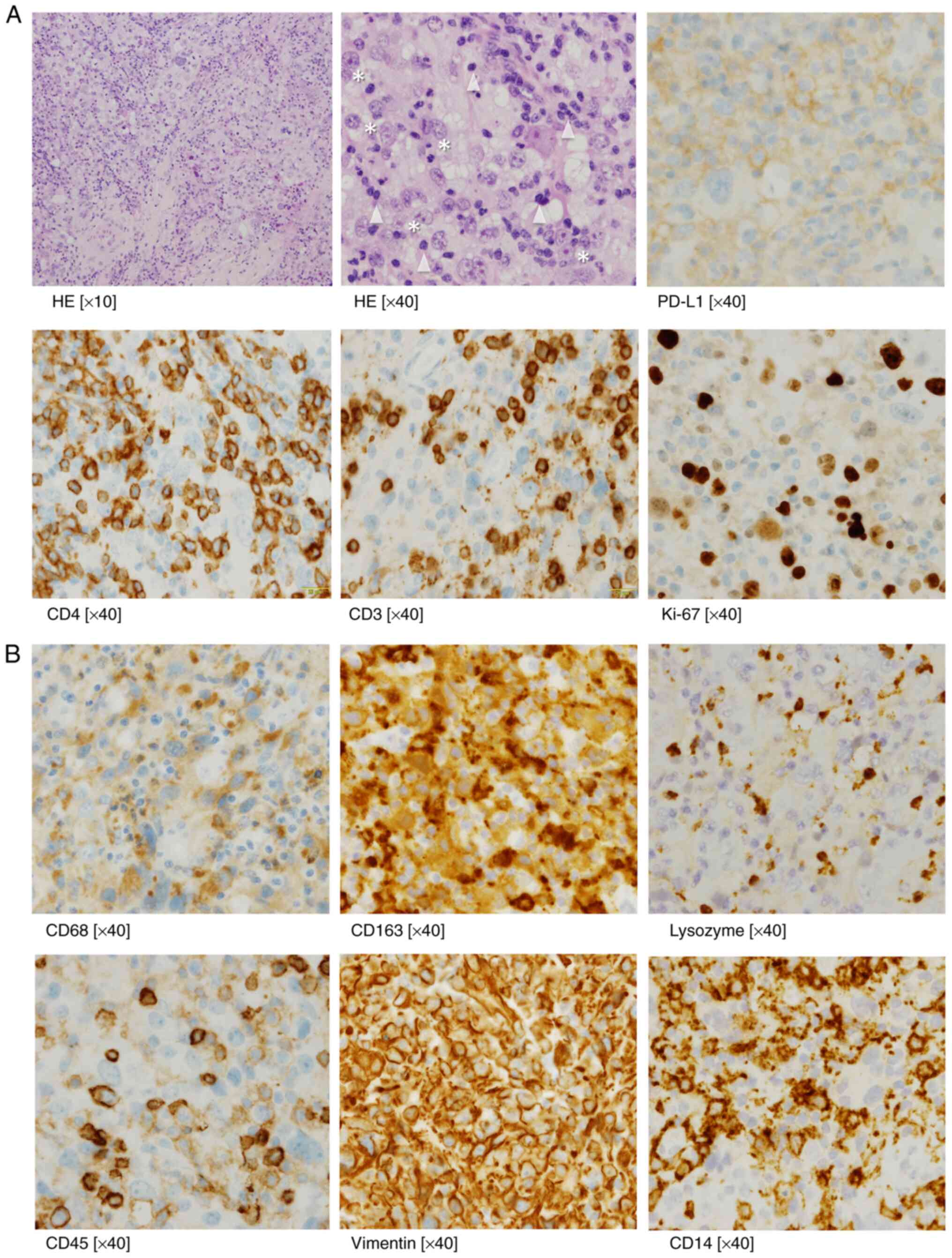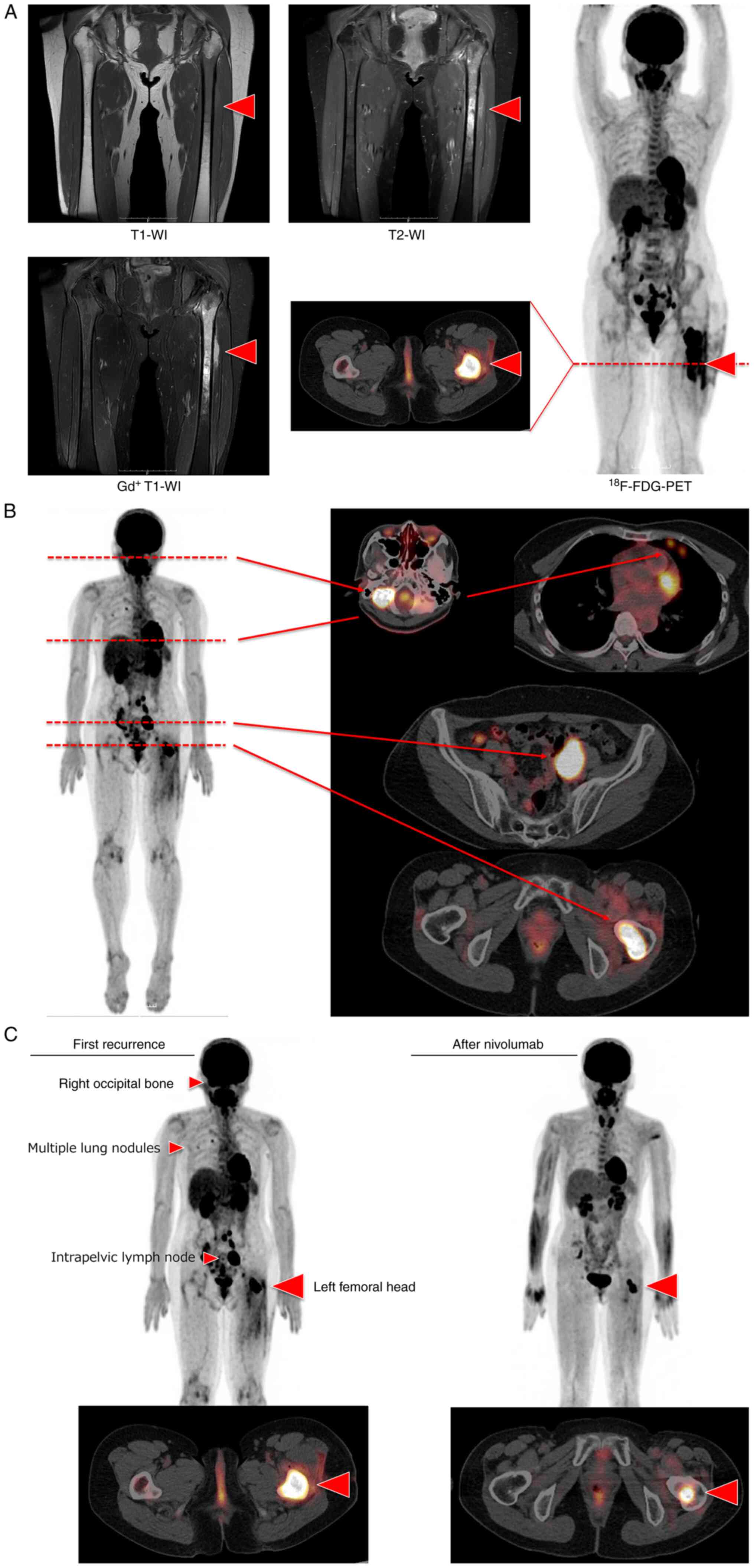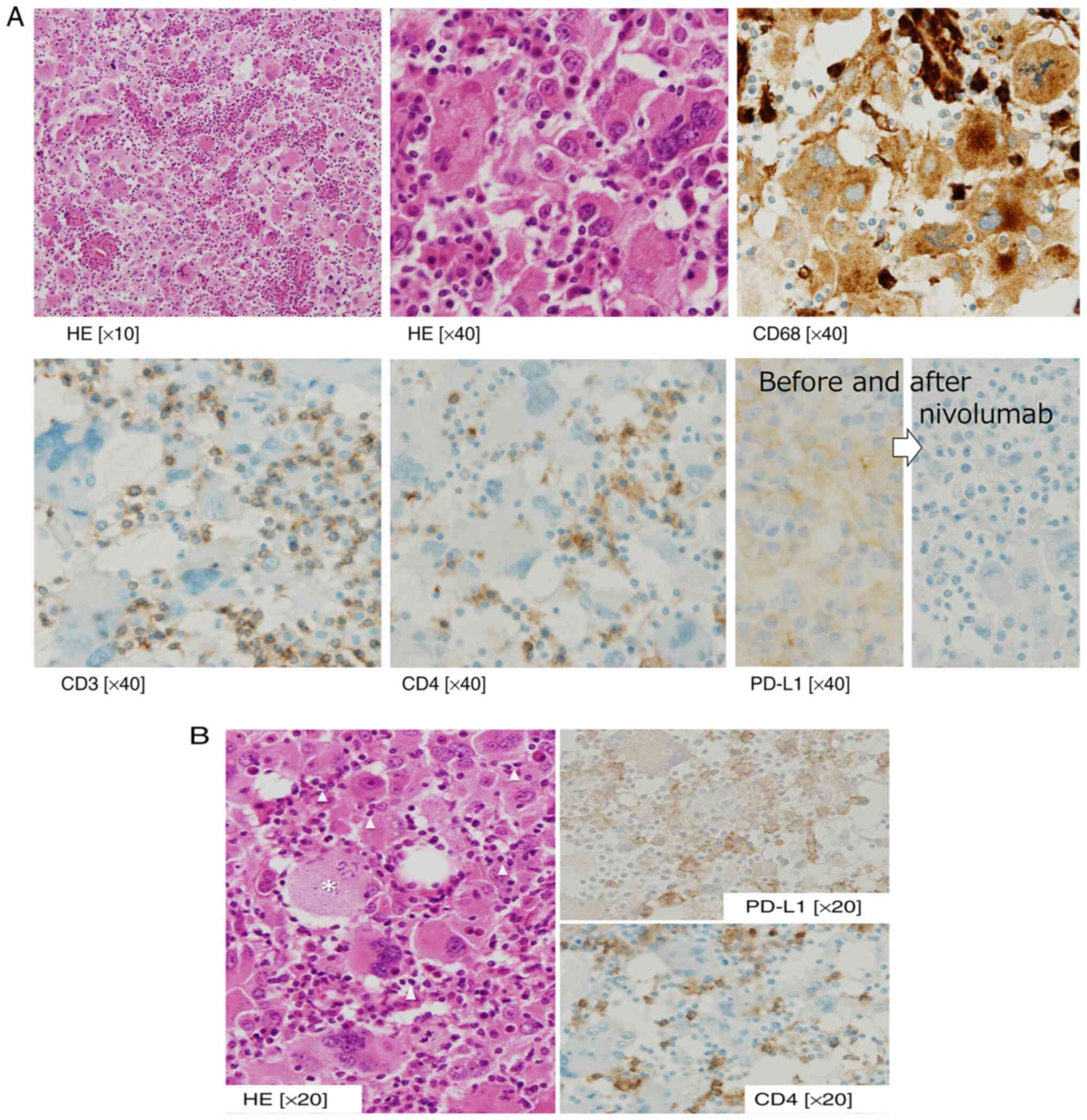|
1
|
Swerdlow SH, Campo E, Harris NL, Jaffe ES,
Pileri SA, Stein H and Thiele J: WHO classification of tumours of
haematopoietic and lymphoid tissues. Revised Fourth Edition World
Health Organization classification of tumours. IARC, Lyon,
2017.
|
|
2
|
Swerdlow SH, Campo E, Pileri SA, Harris
NL, Stein H, Siebert R, Advani R, Ghielmini M, Salles GA, Zelenetz
AD and Jaffe ES: The 2016 revision of the world health organization
classification of lymphoid neoplasms. Blood. 127:2375–2390.
2016.PubMed/NCBI View Article : Google Scholar
|
|
3
|
Emile JF, Abla O, Fraitag S, Horne A,
Haroche J, Donadieu J, Requena-Caballero L, Jordan MB, Abdel-Wahab
O, Allen CE, et al: Revised classification of histiocytoses and
neoplasms of the macrophage-dendritic cell lineages. Blood.
127:2672–2681. 2016.PubMed/NCBI View Article : Google Scholar
|
|
4
|
Hung YP and Qian X: Histiocytic sarcoma.
Arch Pathol Lab Med. 144:650–654. 2020.PubMed/NCBI View Article : Google Scholar
|
|
5
|
Gatalica Z, Bilalovic N, Palazzo JP,
Bender RP, Swensen J, Millis SZ, Vranic S, Von Hoff D and Arceci
RJ: Disseminated histiocytoses biomarkers beyond BRAFV600E:
Frequent expression of PD-L1. Oncotarget. 6:19819–19825.
2015.PubMed/NCBI View Article : Google Scholar
|
|
6
|
Dong H, Zhu G, Tamada K and Chen L: B7-H1,
a third member of the B7 family, co-stimulates T-cell proliferation
and interleukin-10 secretion. Nat Med. 5:1365–1369. 1999.PubMed/NCBI View
Article : Google Scholar
|
|
7
|
Keir ME, Francisco LM and Sharpe AH: PD-1
and its ligands in T-cell immunity. Curr Opin Immunol. 19:309–314.
2007.PubMed/NCBI View Article : Google Scholar
|
|
8
|
May JM, Waddle MR, Miller DH, Stross WC,
Kaleem TA, May BC, Miller RC, Jiang L, Strong GW, Trifiletti DM, et
al: Primary histiocytic sarcoma of the central nervous system: A
case report with platelet derived growth factor receptor mutation
and PD-L1/PD-L2 expression and literature review. Radiat Oncol.
13(167)2018.PubMed/NCBI View Article : Google Scholar
|
|
9
|
Gounder M, Desai V, Kuk D, Agaram N,
Arcila M, Durham B, Keohan ML, Dickson MA, D'Angelo SP, Shukla N,
et al: Impact of surgery, radiation and systemic therapy on the
outcomes of patients with dendritic cell and histiocytic sarcomas.
Eur J Cancer. 51:2413–2422. 2015.PubMed/NCBI View Article : Google Scholar
|
|
10
|
Iwabuchi H, Kawashima H, Umezu H, Takachi
T, Imamura M, Saitoh A, Ogose A and Imai C: Successful treatment of
histiocytic sarcoma with cladribine and high-dose cytosine
arabinoside in a child. Int J Hematol. 106:299–303. 2017.PubMed/NCBI View Article : Google Scholar
|
|
11
|
Kommalapati A, Tella SH, Durkin M, Go RS
and Goyal G: Histiocytic sarcoma: A population-based analysis of
incidence, demographic disparities, and long-term outcomes. Blood.
131:265–268. 2018.PubMed/NCBI View Article : Google Scholar
|
|
12
|
Ansari J, Naqash AR, Munker R, El-Osta H,
Master S, Cotelingam JD, Griffiths E, Greer AH, Yin H, Peddi P and
Shackelford RE: Histiocytic sarcoma as a secondary malignancy:
Pathobiology, diagnosis, and treatment. Eur J Haematol. 97:9–16.
2016.PubMed/NCBI View Article : Google Scholar
|
|
13
|
Skala SL, Lucas DR and Dewar R:
Histiocytic Sarcoma: Review, discussion of transformation from
B-cell lymphoma, and differential diagnosis. Arch Pathol Lab Med.
142:1322–1329. 2018.PubMed/NCBI View Article : Google Scholar
|
|
14
|
Bose S, Robles J, McCall CM, Lagoo AS,
Wechsler DS, Schooler GR and Van Mater D: Favorable response to
nivolumab in a young adult patient with metastatic histiocytic
sarcoma. Pediatr Blood Cancer. 66(e27491)2019.PubMed/NCBI View Article : Google Scholar
|
|
15
|
Tzankov A, Kremer M, Leguit R, Orazi A,
van der Walt J, Gianelli U and Hebeda KM: Histiocytic cell
neoplasms involving the bone marrow: Summary of the workshop cases
submitted to the 18th meeting of the European association for
haematopathology (EAHP) organized by the European bone marrow
working group, basel 2016. Ann Hematol. 97:2117–2128.
2018.PubMed/NCBI View Article : Google Scholar
|
|
16
|
Bubolz AM, Weissinger SE, Stenzinger A,
Arndt A, Steinestel K, Brüderlein S, Cario H, Lubatschofski A,
Welke C, Anagnostopoulos I, et al: Potential clinical implications
of BRAF mutations in histiocytic proliferations. Oncotarget.
5:4060–4070. 2014.PubMed/NCBI View Article : Google Scholar
|
|
17
|
Takahashi E and Nakamura S: Histiocytic
sarcoma: An updated literature review based on the 2008 WHO
classification. J Clin Exp Hematop. 53:1–8. 2013.PubMed/NCBI View Article : Google Scholar
|
|
18
|
Kommalapati A, Tella SH, Go RS and Goyal
G: Predictors of survival, treatment patterns, and outcomes in
histiocytic sarcoma. Leuk Lymphoma. 60:553–555. 2019.PubMed/NCBI View Article : Google Scholar
|
|
19
|
Shimono J, Miyoshi H, Arakawa F, Sato K,
Furuta T, Muto R, Yanagida E, Sasaki Y, Kurita D, Kawamoto K, et
al: Prognostic factors for histiocytic and dendritic cell
neoplasms. Oncotarget. 8:98723–98732. 2017.PubMed/NCBI View Article : Google Scholar
|
|
20
|
Liu Z, Xiao Y, Liu X, Li Q, Liu T, Zhu F,
Wu G and Zhang L: Case Report: Long-term response to radiotherapy
combined with targeted therapy in histiocytic sarcoma harboring
mutations in MAPK and PI3K/AKT pathways. Front Oncol.
11(755893)2021.PubMed/NCBI View Article : Google Scholar
|
|
21
|
Hu B, Patel JL, Tao R, Cannon RB, Monroe M
and Goyal G: Near complete response to trametinib treatment in
histiocytic sarcoma harboring a somatic KRAS mutation. J Natl Compr
Canc Netw. 24:1–4. 2022.PubMed/NCBI View Article : Google Scholar
|
|
22
|
Branco B, Comont T, Ysebaert L, Picard M,
Laurent C and Oberic L: Targeted therapy of BRAF V600E-mutant
histiocytic sarcoma: A case report and review of the literature.
Eur J Haematol. 103:444–448. 2019.PubMed/NCBI View Article : Google Scholar
|
|
23
|
Tomlin J, Orosco RK, Boles S, Tipps A,
Wang HY, Husseman J and Wieduwilt M: Successful treatment of
multifocal histiocytic sarcoma occurring after renal
transplantation with cladribine, high-dose cytarabine, G-CSF, and
mitoxantrone (CLAG-M) followed by allogeneic hematopoietic stem
cell transplantation. Case Rep Hematol. 2015(728260)2015.PubMed/NCBI View Article : Google Scholar
|
|
24
|
Gergis U, Dax H, Ritchie E, Marcus R,
Wissa U and Orazi A: Autologous hematopoietic stem-cell
transplantation in combination with thalidomide as treatment for
histiocytic sarcoma: A case report and review of the literature. J
Clin Oncol. 29:e251–e253. 2011.PubMed/NCBI View Article : Google Scholar
|
|
25
|
Visonneau S, Cesano A, Tran T, Jeglum KA
and Santoli D: Successful treatment of canine malignant
histiocytosis with the human major histocompatibility complex
nonrestricted cytotoxic T-cell line TALL-104. Clin Cancer Res.
3:1789–1797. 1997.PubMed/NCBI
|

















